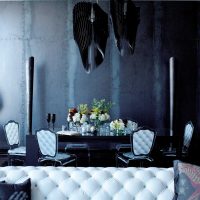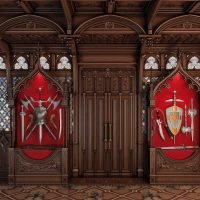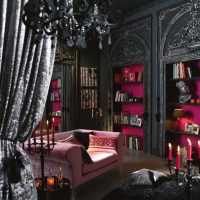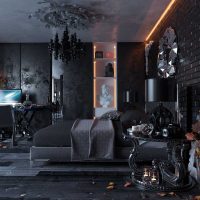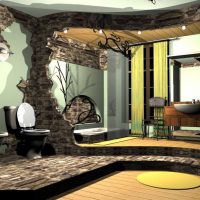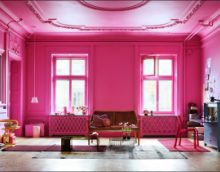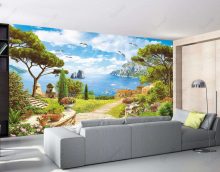Gothic style interior design
In the XIII century, initially in architecture, and then in the interior, a style appeared, which is called Gothic. For the first time, the great Raphael so called him, and in a derogatory sense. He contrasted the style of St. Peter's with Roman aesthetic models, and in a report to the Pope about how the construction was going, he called it Gothic, in the sense devoid of true beauty, barbaric.

Gothic style in interior design

Gothic style room interior

Unusual design of the apartment in the Gothic style
Content
Features of the stylization of the Gothic interior
The Gothic style of the interior has some kind of mysticism - stained-glass windows, striking in multicolor, on huge windows, lancet arches. The main distinguishing feature of the style is vertical elements, there are a lot of them, as if the whole space rushes up, due to which rigor, grandeur is achieved. Among other important elements that distinguish the interior in the Gothic style:
- very large windows;
- plenty of light;
- complex forms of arches.

Gothic style in the interior of the apartment

Gothic style apartment design
Gothic combines aristocratic elegance with sophistication and grandeur. Since the Middle Ages, the style has undergone many changes, it received a new life in the XIX-XX centuries, but even now its features can be traced in the interior design of expensive restaurants, hotels and some country houses. Style will allow you to create a unique interior, but it is hardly suitable for small-sized "Khrushchevs" and panel high-rise buildings - Gothic style requires space, height and plenty of light.
And in a country mansion, apartments there is an opportunity to turn around, but even here you should not reproduce the Gothic interior in its original form - it may turn out to be a mystically gloomy room. Prefer styling in the Gothic spirit, choosing the main features to emphasize the luxury of the interior.

Gothic style in interior design

Gothic style room interior

Unusual design of the apartment in the Gothic style
Modern gothic interior
First of all, the gothic style in the interior is space and a lot of light. Therefore, it is better to choose spacious rooms with high ceilings for styling. If you originally conceived the design of the cottage in the Gothic style - pay attention to the windows - they should be high, terminated from above by an arch with pointed points. The shape of the windows is elongated, vertical.
For interior design, only natural materials are supposed, among which three should be preferred:
- a natural stone;
- tree;
- metal.
Plastic, artificial materials - this is not for Gothic. Leave them contemporaneous, but marble will be appropriate here, expensive woods - for furniture that will be decorated with carvings. It can be decorated with gilding, because the main thing in the Gothic interior is chic and luxury. The right choice of materials and the distribution of all decorative elements will create a living room in the style of medieval castles, and a bedroom in the style of royal chambers.

Gothic style in the interior of the apartment

Gothic style apartment design
Materials for decoration
Naturalness is the main requirement when choosing materials.The walls in the Gothic interior are not the main thing, they are usually monophonic, but you can decorate them:
- wood paneling;
- mosaic;
- tapestries.
This is in case if it is not planned to make stained glass windows, there is no possibility of creating arches, niches, otherwise it will clutter up the space, and the main requirement of the style - air, space, will not be met. After all, the vertical features characterizing the Gothic style did not appear by chance - it is a desire to go up into the expanse of heaven.
Floor - it is better to make a plank or stone. The ceiling in the Gothic style involves painting or decorating with wooden beams.
Windows are a special detail of the interior, which is the organizing center for creating a stylized space. The historical Gothic building is characterized by tall narrow windows, ending at the top with an arch divided into sectors. Another type of window that characterizes the interior of the Gothic style is the so-called "Gothic rose" - a rounded window divided by binding into equal parts in the form of a figured star, a blossoming flower.
In a modern design, such a window can become a decoration of the facade of a country cottage. But most often they are limited to large windows around the perimeter, decorated with stained-glass windows. They will give the facade an unusual look, and decorate the interior. In the historical understanding of the interior of the Gothic style, they should go around the perimeter of the house, letting in a lot of light into the room, creating an unusual effect.

Gothic style in interior design

Gothic style room interior

Unusual design of the apartment in the Gothic style
Gothic color palette
Color for the Gothic in the interior is important. To create a room close to historical stylization, light shades are selected as the main tone: white, beige, milk. They will allow you not to look gloomy in a room that uses the typical gothic color scheme:
- cherry;
- ruby;
- purple;
- Gray;
- Navy blue;
- blue and black tones.
Without a light background, the room would have looked gloomy, dull. It is especially brightly played by multi-colored stained-glass windows in which a variety of colors can be used: red, brown, yellow, blue.
In stained-glass windows, as well as in the decoration of furniture, decor items, wooden or stone carved elements, gold and silver threads are allowed.

Gothic style in the interior of the apartment

Gothic style apartment design
Gothic furniture
If everything in the Gothic interior tends to go up, then the furniture is even more so. It should be high:
- double-wing high cabinets;
- cupboards for dishes on high legs;
- massive beds with high headboards;
- upholstered chairs with high backs.
The table is massive, with a drawer protruding forward. Solid, luxurious furniture is made of dark wood, it can be decorated with carvings, complemented by wrought iron fittings. Doors of cabinets in the living room and kitchen can be decorated with stained glass inserts. Often, cabinets are decorated with "Gothic roses", thereby emphasizing the stylization of the interior. Dark carved elements of cabinets, beds, tables can be coated with gold, silver paint.
Important! Any furniture in the Gothic style should have its secrets - secret drawers, caskets, chests.

Gothic style in interior design

Gothic style room interior

Unusual design of the apartment in the Gothic style
In the living room, chairs reminiscent of the royal throne with high backs and armrests, round tables with carved legs are appropriate. They will be complemented by marble countertops, mirrors framed by a massive frame. A mandatory element of the living room is a fireplace with a metal grill in a wooden frame. Ideally, if it is decorated with Gothic ornaments, Celtic symbols. The fireplace can be decorated with natural stone, marble, for example.
The bedroom should have a wide bed with carved columns and a canopy, or forged with a high headboard. Here, too, you can put a mirror, a table, a high wardrobe. A wooden chest with wrought-iron elements, a wicker rocking chair will complete the stylization.
Important! Do not oversaturate the interior, trying to fit all the elements of style into it. Choose a few - otherwise, instead of luxurious, you can get a gloomy house, evoking despondency.

Gothic style in the interior of the apartment
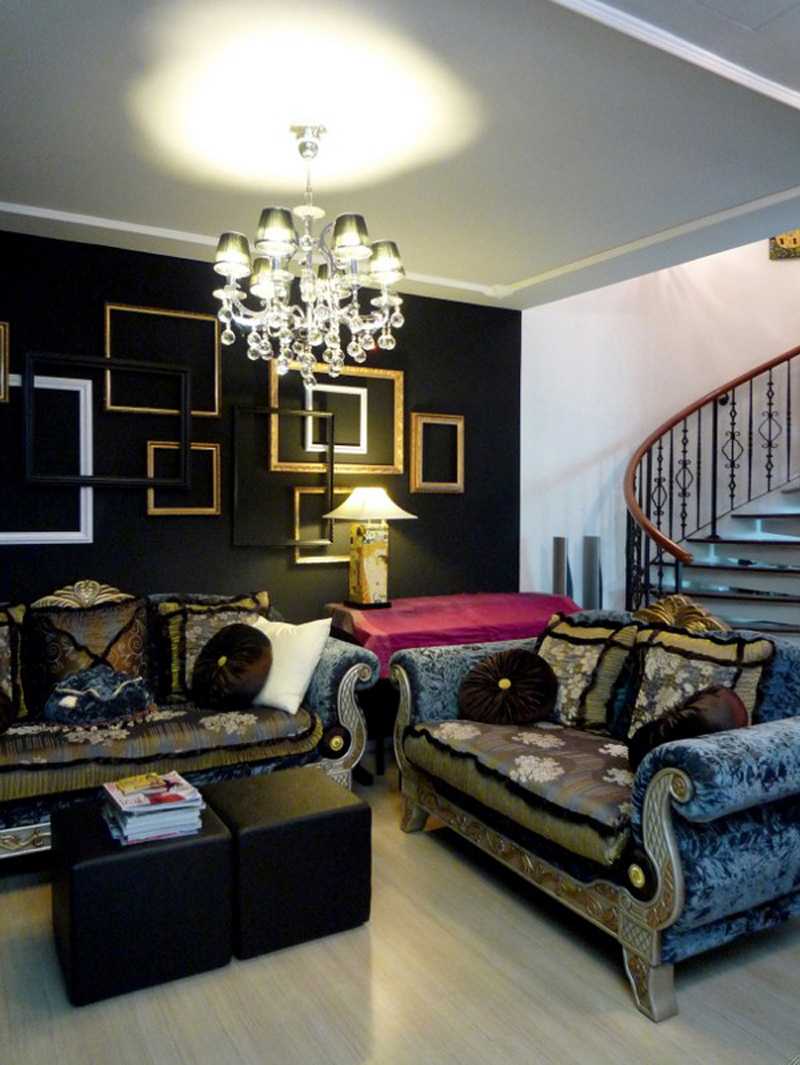
Gothic style apartment design
Decor of a modern gothic interior
In order not to oversaturate the interior with details characteristic of the Gothic style, do not get carried away with numerous decorations. Balance the space.
- If the windows are decorated with stained-glass windows - curtains are not needed. However, it is possible to decorate interior doors, furniture facades with stained-glass windows, then decorate the windows with dense heavy curtains on forged or massive wooden cornices.
- Plain walls can be supplemented with tapestries or tapestries - Gothic paintings do not accept. Tapestry plots are best found in medieval subjects - knights, castles.
- Upholstery of upholstered furniture - expensive fabrics: brocade, velvet. The color scheme is better to choose dark - burgundy, dark blue, with a jacquard pattern or smooth structure.
- "Gothic rose" in itself is already a means of stylization, and its location on the facades of cabinets, a fireplace is an element of decor.

Gothic style in interior design

Gothic style room interior

Unusual design of the apartment in the Gothic style
Fancy and sophisticated objects will be appropriate in the Gothic living room - everything should emphasize the high status of the owners: stone sculptures, figures carved in wood or ivory, metal figurines, wrought iron furniture, massive candle holders.
Gothic interiors pay much attention to light - a massive chandelier made of steel on low suspensions, decorated with wrought iron candlesticks will complete the stylization. It is hung in the center of a high spacious living room and can be supplemented by pendant lights, wall sconces.

Gothic style in the interior of the apartment

Gothic style apartment design
The main task of choosing a Gothic style for the interior is to create an atmosphere of a rich medieval castle. Given that in the conditions of a modern home it is difficult to achieve full style compliance, it is better to choose only some elements characteristic of Gothic style. They will create the effect of luxury without overloading the space.
Video: Gothic style in the interior






